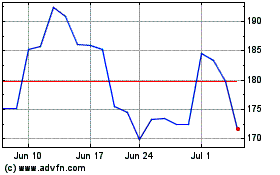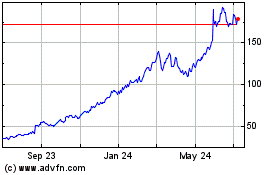UPDATE: Concerns About Rising Cotton Costs Weighing On Retailers
May 20 2011 - 2:33PM
Dow Jones News
Fears that retailers may have a tougher time than thought with
rising cotton prices are reverberating throughout the group and
causing a mass sell-off Friday in apparel stocks.
Gap Inc. (GPS), the largest U.S. apparel-specific retailer by
sales, spurred the alarm late Thursday by saying raw-material costs
are rising faster than expected and that the company will be unable
to fully counter them with price increases. Gap gave what is
seemingly the highest, and clearest, estimate yet, saying cost per
clothing item will be up 20% in the second half of the year.
The magnitude of the increase is notable considering the buying
power that Gap's size gives it. Pegging off of Gap, questions are
being raised about what kinds of increases other apparel retailers
will have to deal with.
"It's almost like Gap made everybody reassess what the potential
cost impact is for all the apparel retailers and apparel
manufacturers," said Mark Montagna, retail analyst with Avondale
Partners.
In comments starting last year, retail executives spoke of
coming price increases. But many were vague. Macy's Inc. (M) Chief
Financial Officer Karen Hoguet said last week she felt concerns
about price inflation were "overstated," at least for her company.
As one of the biggest department stores, Macy's has the ability to
play one merchant off of another to get better pricing, Montagna
said. The company can also add more detail to apparel, resulting in
less need for cotton. Target Corp. (TGT) this week was one of the
most definitive, saying it sees double-digit percentage increases
for both apparel and soft home merchandise, like towels and
bedding, this fall.
Cotton prices touched a high of $2.27 a pound in early March
after bad weather hurt output in major producers India and China,
and mills rushed to stock up on the fiber. Prices have retreated
but are still more than double the 10-year average of 62 cents a
pound.
Retailers have also generally said they felt comfortable they
would be able to pass the cost increases along to customers to a
large degree.
If this isn't the case, it becomes more complicated for
retailers because their customers are already struggling with
rising gas and food prices as well as still-high unemployment.
Gap was the largest decliner in the Standard & Poor's 500
Index Friday, recently down 17.1% at $19.30. Teen retailer
Aeropostale Inc. (ARO), which gave an extremely weak second-quarter
view late Thursday, also saw a large loss, with shares off 14% at
$18.30.
Aeropostale did indicate that cost increases are "somewhat"
below its previous 10% to 15% range, but that may not help the
company much because it is so promotional. Aeropostale's women's
products have failed to entice buyers, and the retailer said its
second-quarter outlook reflects plans for "aggressive markdowns" to
clear through spring merchandise before the back-to-school season.
Janney Capital Markets also expressed concern that cost inflation
may impact Aeropostale disproportionately compared with retailers
that target a higher-income market given its more price-sensitive
customers.
Other retailers selling off Friday included American Eagle
Outfitters Inc. (AEO), down 6.5% at $13.67, and Abercrombie &
Fitch Co. (ANF), off 2.1% at $73.93. Meanwhile, shares of
department stores also declined, with J.C. Penney Co. (JCP) sliding
4.1% to $36.41 and Macy's Inc. (M) off 2.3% at $28.83. Among
apparel manufacturers, Phillips-Van Heusen Corp. (PVH) is off 5.2%
at $65.51 and Lee and Wrangler maker VF Corp. (VFC) is down 4.5% at
$97.63.
But shares of Zumiez Inc. (ZUMZ), which sells action
sports-related apparel and equipment, bucked the weakness plaguing
the retail sector. Zumiez is seen as somewhat of a safe haven from
the pressure of rising raw materials costs, as about half of its
products are not cotton-based and it carries unique brands that can
often command higher prices. Zumiez's shares were up 5.7% at $27.80
after it posted better-than-expected first-quarter results and
issued what was generally considered a conservative second-quarter
view.
Overall, retailers' stocks had been faring well until recently,
outpacing the broader market. The S&P 500 Retail Index had
risen nearly 12% over two months through the middle of May,
doubling the gain in the main S&P 500 during that period.
Friday, though, the retail index was down 0.9%, while the S&P
500 was off 0.2%.
-By Caitlin Nish, Dow Jones Newswires; 212-416-2076;
caitlin.nish@dowjones.com
-By Karen Talley, Dow Jones Newswires; 212-416-2196;
karen.talley@dowjones.com
Abercrombie and Fitch (NYSE:ANF)
Historical Stock Chart
From Jun 2024 to Jul 2024

Abercrombie and Fitch (NYSE:ANF)
Historical Stock Chart
From Jul 2023 to Jul 2024
